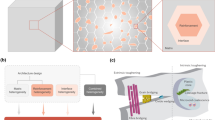Abstract
A technique for calculating the adhesion-diffusion formation of a multilayer metal-ceramic structure is presented. The development of this technique is dictated by requirements imposed on the wall of the liquid metal flow channel of a fusion reactor blanket. The parameters of the adhesion-diffusion process (pressure, temperature, hold-up time, and the physical properties of materials) are related to the strength characteristics of the resulting composite (incompleteness of the adhesion contact, adhesion energy, and energy and strength of cohesion). Results are illustrated by calculating the formation parameters of the multilayer metal-ceramic structure and its strength as applied to the fusion reactor liquid-metal blanket.
Similar content being viewed by others
References
I. R. Kirillov, N. D. Kraev, V. P. Ostapenko, A. E. Rusanov, and I. V. Vitkovsky, in Proceedings of the 1st Internattional Workshop on Liquid Metal Blanket Experimental Activities, Paris, 1997, pp. 158–161.
I. V. Vitkovsky, F. N. Konev, V. S. Shorkin, N. D. Kzaev, A. E. Rusanov, V. M. Khoroshikh, and S. L. Leonov, Plasma Devices Op. 11, 81 (2003).
I. V. Vitkovsky, A. N. Konev, V. S. Shorkin, and S. I. Yakushina, Tech. Phys. 52, 705 (2007).
I. V. Vitkovsky, A. N. Konev, V. S. Shorkin, and S. I. Yakushina, Tech. Phys. 54, 170 (2009).
V. S. Shorkin, L. Yu. Frolenkova, and A. S. Azarov, Materialovedenie, No. 2, 2 (2011).
L. D. Landau and E. M. Lifshitz, Course of Theoretical Physics, Vol. 5: Statistical Physics (Nauka, Moscow, 1976; Pergamon, Oxford, 1980).
A. S. Azarov and V. S. Shorkin, Izv. Tul’sk. Gos. Univ., Ser. Estestv. Nauki, No. 1, 28 (2009).
A. S. Azarov and V. S. Shorkin, in Proceedings of the 47th International Conference on Active Problems of Strength, Nizhnii Novgorod, 2008, pp. 163–165.
Ya. S. Podstrigach, Vopr. Mekh. Real. Tverd. Tela, No. 2, 77 (1964).
A. G. Knyazeva, in Proceedings of the International Conference RDAMM-2001, Special Issue, Vol. 6, Chap. 2, pp. 191–196.
L. D. Landau, A. I. Akhiezer, and E. M. Lifshitz, General Physics Mechanics and Molecular Physics (Nauka, Moscow, 1965; Pergamon, 1967).
R. de Groot and P. Mazur, Nonequilibium Thermodynamics (North-Holland, Amsterdam, 1962; Mir, Moscow, 1964).
T. D. Shermergar, Theory of Elasticity of Microheterogeneous Media (Nauka, Moscow, 1977) [in Russian].
Handbook of the Properties of Elements, Ed. by G. V. Samsonov (Metallurgiya, Moscow, 1976) [in Russian].
B. A. Loomis, L. J. Niwiccji, and D. L. Smith, Fusion Materials Semiannual Progress Report for Period Ending, March 31, 1995, DOE/ER-0313/18, pp. 265–272.
A. L. Garson, Theoretical Basis of Engineering Calculus, No. 1, pp. 1–16 (Mir, Moscow, 1975).
V. Tvergarden, Int. J. Struct. 25, 1143 (1989).
I. V. Kragel’skii, Friction and Wear (Mashinostroenie, Moscow, 1968) [in Russian].
I. G. Goryacheva, Mechanics of Friction Interaction (Nauka, Moscow, 2001) [in Russian].
GOST (State Standard) 25142-82: Asperity: Definition and Determination, 1982.
V. S. Shorkin, Prikl. Probl. Prochn. Plastichn., No. 54, 222 (1996).
A. G. Derengovskii, Harden Technologies and Coatings (Mashinostroenie, Moscow, 2006), No. 12, pp. 54–56.
Reha Artan, Turk. J. Eng. Env. Sci. 25, 391 (2001).
Yu. N. Rabotnov, Introduction to Fracture Mechanics (Nauka, Moscow, 1987) [in Russian].
L. Yu. Frolenkova, V. S. Shorkin, and S. I. Yakushina, Fundament. Prikl. Probl. Tekh. Tekhnol., No. 3 (287), 3 (2011).
N. Petch, “Metallographic Aspects of Fracture,” in Fracture: An Advanced Treatise, Ed. by Liebowitz (Academic, New York, 1968; Mir, Mocow, 1973), Vol. 1, pp. 376–420.
K. N. Mikaelyan, M. Yu. Gutkin, and E. S. Aifantis, Phys. Solid State 42, 1659 (2000).
B. A. Pint, Y. L. Moser, and P. F. Tortorelli, J. Nucl. Mater. 367–370, 1150 (2007).
Author information
Authors and Affiliations
Corresponding author
Additional information
Original Russian Text © I.V. Vitkovsky, L.Yu. Frolenkova, V.S. Shorkin, 2012, published in Zhurnal Tekhnicheskoi Fiziki, 2012, Vol. 82, No. 7, pp. 117–122.
Rights and permissions
About this article
Cite this article
Vitkovsky, I.V., Frolenkova, L.Y. & Shorkin, V.S. Adhesion-diffusion formation of a multilayer wall for the liquid metal flow channel of a fusion reactor blanket. Tech. Phys. 57, 1013–1018 (2012). https://doi.org/10.1134/S1063784212070249
Received:
Published:
Issue Date:
DOI: https://doi.org/10.1134/S1063784212070249




